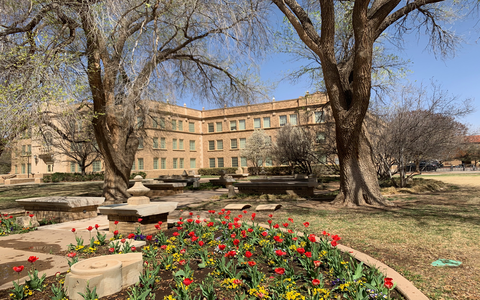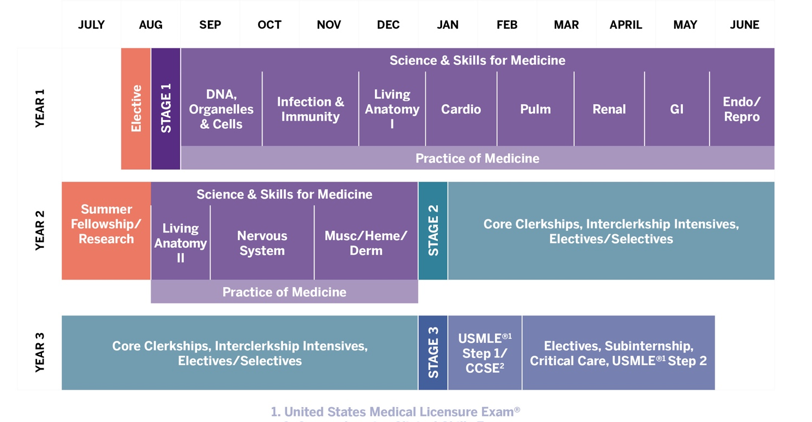While there are many advantages to pursuing accelerated, three-year medical school programs, they’re not for everyone. In this post, we will take an in-depth look at three-year med school program requirements and formats, as well as which schools currently offer this alternative, in order to determine which students would benefit most.
What are Three-Year Med School Programs?
Three-year MD and DO programs satisfy a demand for shorter medical school programs. They save the student a year of tuition and living expenses (as well as a year with no income), and often guarantee a spot in a specialized residency. The complete process of education and training to become a doctor can take up to a decade, so reducing the required time could be very alluring to some students. Three-year programs also help to redress the current shortage of primary care physicians; the AAMC “projects a shortfall of between 21,400 and 55,200 primary care physicians by 2033,” according to this recent article.
With four-year medical programs, the last year is focused on electives and the process of securing a residency position. But there is some debate as to the value of this final year. “Years of [medical school] training have been added without evidence that they enhance clinical skills or the quality of care,” Ezekial Emanuel and Victor Fuchs argued in the Journal of the American Medicine Association in 2012. “This waste adds to the financial burden of young physicians and increases health care costs. The average length of medical training could be reduced by about 30% without compromising physician competence or quality of care.”
The Variety of 3-Year Med School Programs
The number of schools offering three-year MD and DO programs has increased sharply in recent years. The Consortium of Accelerated Medical Pathway Programs, or CAMPP, was created in 2015 with eight medical schools; the Consortium now counts over 20 schools among its members.
The programs vary in terms of whether students are required to practice primary care, whether the students must practice within the same state as the program, and when students apply. In addition, the structure of the programs varies. About half the programs are linked to the medical school’s primary care residency program. Examples include Mercer, Penn State, Texas Tech, UC-Davis. Several other programs, such as NYU, are linked to the school’s residency programs across multiple disciplines; and a few other programs are linked to a specialty program, such as the orthopedics-focused programs at Duke University and Medical University of South Carolina.
Below is a sampling of programs to illustrate the variety of approaches. In addition to the 3-year MD programs, we’ve included a PhD-to-MD program as well as an osteopathic 3-year program.
NYU: 3YMD Pathway
One of the broadest programs is offered by NYU which, unlike many other programs, is not limited to primary care or family medicine. Students must choose their residency of interest prior to application to the 3YMD Pathway. There are currently 21 residency programs, including Internal Medicine, Pathology, Plastic Surgery, and Radiation Oncology. Students can apply when they apply to the MD program, or opt into the three-year pathway in their second or third years. The Three-Year Pathway program starts two weeks before the Four-Year Pathway program, and students work in the department of their intended residency during the summer between their first and second years. Students can transfer to the Four-Year MD pathway, if necessary, due to residency change or otherwise. The graphic below lays out the timeline for the 3-Year Pathway program.
Texas Tech University Health Sciences Center: Family Medicine Accelerated Track (FMAT)
FMAT’s goal is to prepare primary care physicians more efficiently at lower cost. This program culminates in the MD degree and leads to a standard three-year family medicine residency at one of three Texas Tech programs, in Lubbock, Amarillo, or the Permian Basin. FMAT is limited to 16 students per year in each class. Students may apply for the FMAT program when they apply for admission or during the winter (November through January) of their first year of medical school. Tech School of Medicine provides scholarship support to FMAT students for at least one year of medical school.
UC-Davis, School of Medicine: Accelerated Competency-based Education in Primary Care (ACE-PC)
This program is only for students committed to careers in primary care. ACE-PC students start working in Kaiser Permanente primary care clinics within the first few weeks of starting the program and continue in these clinics for three years. Unique curricular content includes population management, chronic disease management, quality improvement, patient safety, team-based care and preventive health skills with special emphasis on diverse and underserved populations. ACE-PC is limited to six to eight students and classes begin in June, six to eight weeks before the classic orientation. Students applying to the four-year M.D. program can express interest in the accelerated program on their secondary applications; if they’re accepted into the four-year program, they may be invited to submit a formal application to ACE-PC.
Mercer University: Primary Care Accelerated Track Program (ACT)
This program is only for students interested in practicing family medicine, general internal medicine, or pediatrics, and who have a strong desire to remain in Georgia. Students apply during the Spring of Year 1 and may opt to return to the four-year program at any time. The curriculum is very similar to their four-year MD program, but is compressed into 130 weeks of instructional time; the ACT scholarship covers tuition for the second and third years. Upon graduation, students are required to practice full-time primary care in a medically underserved rural area of Georgia.
Columbia University: College of Physicians and Surgeons 3-year PhD-to-MD Program
Columbia’s accelerated program is only open to students who have already earned a PhD in biological sciences or a related field and intend to pursue biomedical research as a physician scientist. To this end, applicants are restricted to those interested in practicing cognitive specialties, such as internal medicine, pediatrics, neurology, psychiatry, or pathology. Students can apply for this program when they receive the secondary in the regular medical school application process. The program is divided into preclinical courses (16 months) and major clinical year and electives (17 months). Students begin in August of their first year and finish in May of their third year, working over the summers.
Lake Erie College of Osteopathic Medicine: Primary Care Scholars Pathway (PCSP)
PCSP students must commit to complete a residency in family medicine or general internal medicine, and practice primary care medicine for a minimum of five years upon completion of residency. If a student does not fulfill these requirements, they will be asked to return the scholarship award. Students complete all courses and learning modules required in the first two years of preclinical education in under 20 months, and begin clinical training in March of their second year. Students participate in a sub-internship at the hospital where they will continue their clinical training after graduation.
Conclusion
Accelerated three-year medical school programs are often geared towards careers in primary care but have begun expanding to more specialties (as at NYU) as they’ve experienced increasing success. The shortened programs are extremely academically rigorous, and if students are not meeting academic benchmarks, they are transferred back to the four-year program.
Three-year medical programs mark a focused pathway of study for those students who can commit to a particular specialty and who are willing to work at an advanced pace to opt out of a year of medical school. Nevertheless it is important to weigh the pros and cons of these programs in order to determine whether or not they might be right for you. Pros of the three-year program include reducing your cost of medical education, , knowing where your residency will take place from the start, and beginning your practice a year earlier. Cons include committing to a specialty before gaining experience in medical school, losing out on a fourth year of consolidated learning, and having less time off for vacation and test prep,.
In a 2013 article in the New England Journal of Medicine, Dr. Stanley Goldfarb and Dr. Gail Morrison argued that the fourth year of medical school is a valuable year that should be enhanced with more intense clinical training in outpatient and inpatient settings, as well as increased advising and mentoring, creating a better transition to residency: “There may be exceptional students capable of accelerated learning and small programs that create unusual opportunities for such students, but we believe that for the typical student seeking an M.D. degree, the duration of medical school should not be shortened.” And to complicate the discussion even further, some argue for the benefits of a 5-year medical school education in order to conduct research, complete additional rotations, and become a more competitive applicants for residency programs.
On the other hand, a study published in the Journal of the Association of Medical Colleges in 2021 found that students in accelerated programs “were as satisfied with the quality of their education and felt as prepared for residency” as their peers in standard programs.
Graduate medical study offers many options, and Collegiate Gateway has extensive experience in understanding and weighing the pros and cons of medical training opportunities. Explore our upcoming presentations on our website or set up a complimentary consultation to learn about our admissions consulting services. Whatever your question, Collegiate Gateway is happy to help!


